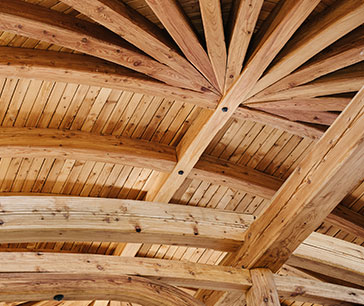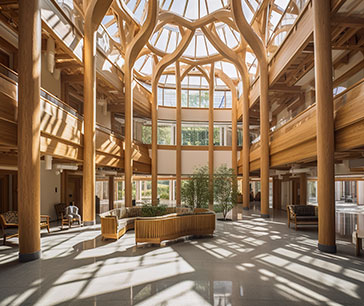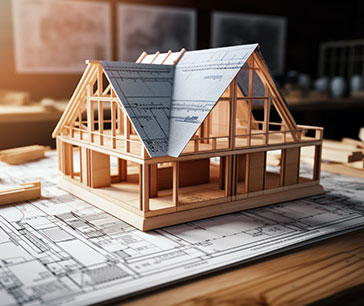Building the Future: Pioneering the Skyline Shift with the Mass Timber Construction Revolution

The energy-efficient alternative to high-rise and commercial buildings is mass timber construction. Wood is a natural, sustainable material, renewable for building, with a lower carbon footprint than concrete or steel. It has positive environmental impacts, is also proven to have the same performance and life safety standards as concrete and steel structures,and is structurally strong.
Mass timber construction is growing owing to its utilization for residential, commercial, and institutional projects. However, local building codes and regulations may influence the extent to which mass timber construction is permitted in each area. As the industry continues to develop, innovations and advancements in mass timber technology are expected to further expand its use in construction.

New Trends in Mass Timber Construction
Mass Timber construction has been progressively used in skyscrapers. There is an increase in focus on the construction of high-rise buildings with wood as the primary structural material owing to technological advancements and research. Modular and prefabrication construction techniques continue to gain traction in mass timber construction projects.
Off-site manufacturing of mass timber allows for reduced construction time, precision engineering, and improved quality control. Digital technologies for building information modeling (BIM) and other technologies are being used in mass timber construction projects. These tools improve project visualization, enhance collaboration, and aid in the design and coordination of complex structures. Advances in connection systems for mass timber components are simplifying assembly processes and improving structural integrity. These systems include innovative joinery techniques, fasteners, and connectors that contribute to the overall efficiency of the mass timber construction industry.
Ongoing research and development focus on enhancing the fire resistance of mass timber materials. Engineered wood products are designed to meet fire safety standards. These advancements continue to enhance their performance in this regard. The mass timber market is witnessing an increase in research initiatives, and collaborative efforts to advance the knowledge and understanding of mass timber construction. This includes partnerships between academia, industry professionals, and research institutions. A key component of mass timber construction continues to see innovations in manufacturing processes, including the use of different wood species, adhesives, and finishes to improve structural performance and aesthetics.
Building Affordable Homes with Mass Timber Construction
Building affordable homes with mass timber construction presents an effective solution, combining the benefits of cost-effectiveness, sustainability, and efficiency. Mass timber construction components are manufactured efficiently in controlled environments as it is a renewable resource. The utilization of sustainably sourced wood helps in the reduction of material costs as compared to traditional construction materials such as steel and concrete. Mass timber components, such as glulam beams, cross-laminated timber (CLT) panels, and others are often prefabricated off-site. This process restricts construction time and labor costs, contributing to overall project affordability.
Prefabricated elements also enhance precision and quality control. Mass timber construction is known for its faster construction timelines. The erection and rapid assembly of prefabricated components can lead to quicker project delivery, saving on both labor costs and financing expenses. Mass timber is lighter than traditional construction materials such as steel and concrete. This characteristic allows for simpler foundation designs and may lead to cost savings in site preparation and foundation construction. Some regions offer incentives and support for sustainable and affordable housing projects. Developers and builders can explore government programs, grants, and tax incentives that promote the use of mass timber construction for affordable housing. For example, in December 2023, The Australian government announced collaborating with 16 countries to develop a policy to promote the use of mass timber, and local councils within Australia. The decision aims to increase the confidence in timber construction manufacturers and boost the industry.
Challenges and Barriers to Mass Timber Construction
Although mass timber construction offers advantages, there are some barriers and challenges that need to be addressed for widespread adoption. These challenges involve various aspects such as regulatory, technical, economic, and perceptual factors.

Building Codes and Regulations: Specific regulations related to fire safety, structural design, and other aspects may need to be updated or clarified to accommodate mass timber construction methods. Many existing regulations and building codes may not be fully aligned with the characteristics of mass timber construction.
Fire Safety Concerns: Addressing these concerns through research, testing, and the development of fire-resistant coatings or technologies is essential. Despite the inherent fire-resistant properties of mass timber, concerns about fire safety can be a barrier to acceptance.
High Initial Costs: Mass timber construction can lead to long-term cost savings; the initial upfront costs may be higher than traditional construction methods. Investments in specialized equipment, technology, and skilled labor can contribute to the initial cost barrier.
Availability of Skilled Labor: The availability of skilled labor capable of working with mass timber construction components may be limited, leading to challenges in the adoption of these construction methods. Mass timber construction requires a workforce with specific skills and knowledge.
Supply Chain Challenges: Expanding and optimizing the supply chain is essential for the scalability of mass timber construction. The supply chain for mass timber components, including the production and transportation of engineered wood products, may face challenges in meeting the demand.
Economic Opportunities in Mass Timber Construction
Mass timber construction, with its lightweight and strong properties, can be considered in regions prone to natural disasters. The economic opportunity lies in developing resilient structures that can withstand seismic events and contribute to disaster recovery efforts. As the mass timber industry grows, there is a demand for education and training services. Institutions and organizations providing training programs for architects, engineers, builders, and workers in mass timber construction can find economic opportunities.
Iconic mass timber buildings and projects can become tourist attractions, drawing attention to the economic opportunities associated with sustainable construction. Showcasing successful mass timber projects can inspire further investment and development. For example, tourism has become an essential contributor to China's domestic economy, contributing to around 11 % of China's GDP. Similarly, according to the India Brand Equity Foundation 2023 report, the tourism & hospitality industry in India booms with a 106% rise in tourist arrivals in 2023. Such growth in the tourism & hospitality industry, especially in developing countries, will positively impact the demand for mass timber construction. Local authorities and governments may offer subsidies and incentives to promote sustainable construction practices.
Builders and developers adopting mass timber construction methods can differentiate themselves in the market. The eco-friendly and sustainable aspects of mass timber can appeal to environmentally conscious consumers, potentially leading to increased market share. Developers and investors may find economic opportunities in mass timber construction by capitalizing on the growing demand for eco-friendly and sustainable buildings. The market for mass timber structures, including residential and commercial properties, presents investment prospects. For instance, in July 2023, the Government of British Columbia invested more than US $4 for million mass-timber demonstration and research projects. The adoption of mass timber construction fosters innovation and the development of new technologies within the construction sector. Companies involved in researching and implementing innovative solutions for mass timber construction can benefit economically.
The Future of Mass Timber Construction
The future of mass timber construction appears promising, with continued innovation and growth expected in the industry. Engineering advancements in the construction industry are expected to lead to even taller and more ambitious mass timber structures. Innovations in technology such as building information modeling (BIM) and digital design tools will improve the precision and efficiency of mass timber construction.

Innovations in connection systems, prefabrication, and modular construction techniques are expected. The global market for mass timber is likely to expand as more countries recognize the environmental and economic benefits of using timber in construction. Export opportunities for mass timber products and expertise may increase. Ongoing research and development efforts will focus on addressing challenges and optimizing mass timber construction methods. This includes improvements in fire safety, acoustic performance, and the development of new mass timber products. Mass timber construction may see increased integration with other construction materials, such as steel and concrete, in hybrid systems. Hybrid construction methods offer flexibility and allow for the optimization of material properties.
The integration of mass timber construction with sensors and monitoring systems will lead to the development of intelligent and efficient buildings. Smart technologies can enhance the performance, maintenance, and sustainability of mass timber structures.
The development of new mass timber products and applications, beyond traditional CLT and glulam, will contribute to the diversification of the industry. This may include the use of mass timber in innovative building components and systems.
The combination of regulatory support, technological advancements, ongoing research efforts, and market demand will guide the future of mass timber construction. The industry's ability to benefit from opportunities and address challenges will shape its trajectory in the future. As the field evolves, staying informed about the trends and latest developments will be essential for industry stakeholders.



